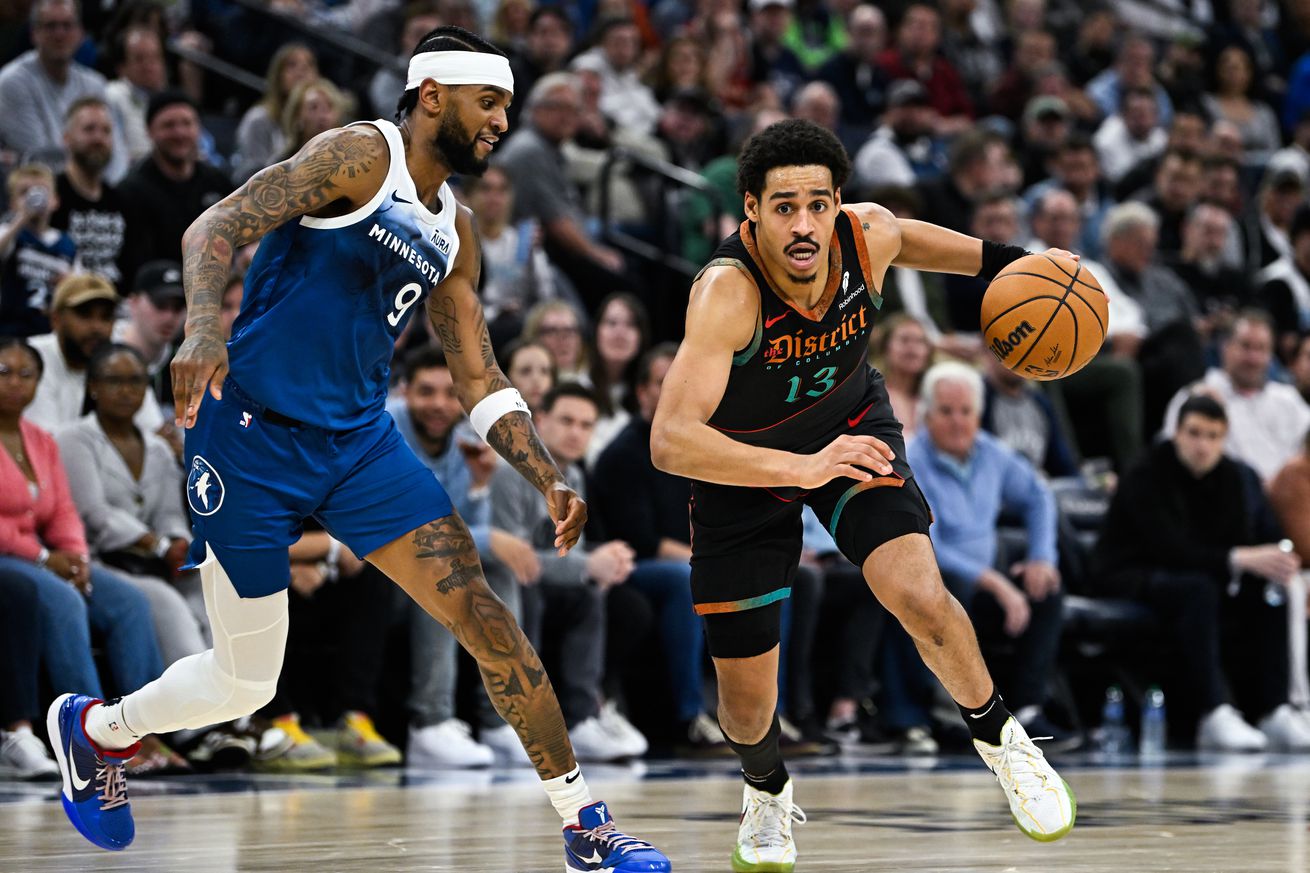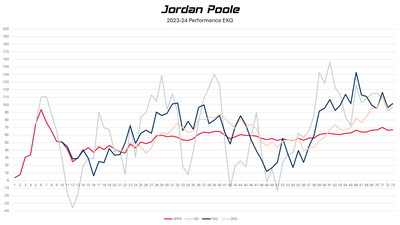
Stats, analysis, commentary.
The season Jordan Poole had for the Washington Wizards defies explanation and conclusions. He was shockingly awful at times, downright great at times, and every now and then, something in between.
While I was cooler on Poole’s abilities as a player than many, I thought he’d shown enough with the Golden State Warriors to be a relatively low-risk bet for a rebuilding team. He probably wasn’t going to become or lead the league in scoring, but he also probably wasn’t likely to just plain suck.
For the first 20+ games of the season, Poole seemed intent on proving my worst-case predictions to be those of a cockeyed optimist. Over his first 25 games in Wizards uniform, Poole rated at replacement level in Player Production Average . (PPA is my overall production metric, which is pace neutral, and accounts for defense and role. In PPA, 100 is average, higher is better, and replacement level is 45.)
His play improved a bit at that point before cratering again over the 10-12 games before interim head coach Brian Keefe moved him to the bench. That move seemed to help — in his final 21 games (which included nine starts in place of the injured Tyus Jones), Poole’s PPA was 95. I mean, that’s still a shade below average, but it’s genuine improvement.
The popular narrative was that Poole was hampered by having to share touches with Jones in the backcourt. The problem with that story? Poole’s touches per minute went down when he moved to the bench.
In his first 52 games, Poole averaged 42.2 frontcourt touches per 48 minutes, according to NBA tracking data. Over his final 21 (dating from the move to the bench), he averaged 37.7. Over his final nine games (all starts), he averaged 38.3 touches per 48 minutes.
In other words, Poole’s touches dropped, and he played better.
Things stay weird with him, though. Even when he was “good,” Poole’s performance was maddeningly inconsistent. Over the course of the entire season, he managed two games in a row of average or better performance just five times. He strung together three straight 100+ PPA games only once.
He rated in negative territory in two or more consecutive games six times, and had two stretches as a net negative in three games in a row. Somehow, he had as many negative games (25) as he did that rated average or better.
- 200+ PPA — 8x, 11%
- 150+ — 17x, 23%
- 100+ — 25x, 34%
- 100> — 48x, 66%
- 45> — 33x, 45%.
- Negative — 25x, 34%
He also had two games with a 300+ PPA — a 356 in a blowout loss to the Boston Celtics, and a 317 in an 11-point loss to the Utah Jazz.
The challenge in figuring what anything from his season means is his terrific games were generally surrounded by duds…and the duds were much more plentiful. For the season, 34% of Poole’s games rated in the negative. Over the final 21 games when he moved to the bench and was “good” — 28% rated in the negative. Over the final 21 games, 38% rated average or better — about the same as his full season numbers.
In other words, even when he was “good,” his play was still abysmal at about the same rate as it was when he was bad. His average went up because he had a few great games (though at about the same rate as he did the rest of the season).
Poole’s biggest hurdle this season was offensive efficiency. In a league that averaged 115.4 points per 100 possessions, he produced 102.9. His combination of high usage and poor efficiency was second worst in the league. My +PTS (plus-points) stat estimates his brand of offense cost the Wizards 158 points last season. Only Scoot Henderson, the Portland Trail Blazers rookie, was worse.
To further confound things, play type tracking indicates there isn’t much to build on with him. He was about average in isolation and below average at virtually everything else teams want guards to do (transition, pick-and-roll, spot up shooting). He was decent on cuts and shooting off screens — both off-ball actions that once again defy the narrative that he needs to play on-ball to be successful.
Probably best to chalk it up to “bad season” and ask Poole to make the “play better” adjustment. He seems to have talent, and he’s alleged to be a hard worker, so perhaps an offseason could see him improved in areas like strength, balance, ball-handling, shooting and decision-making.
Below my “performance EKG” for Poole. These ekgs track a player’s production game-by-game throughout the season. The red line is the player’s full season PPA after each to that point in the season. The gray line is a five-game moving average, the blue is a 10-game moving average, and the pink is a 20-game average.

Observations:
- Poole had two 20-game stretches of the season that rated average or better. The stretches overlapped and came during the 21 games after Keefe removed him from the starting lineup.
- Poole didn’t have a single 10-game stretch in which his offensive efficiency surpassed league average. He hit a 115 offensive rating for the 10 games from February 29 to March 17. Over his next (last) seven games: 102. His season average: 103.
- After putting up a season-best 356 PPAon March 17 against Boston, Poole’s final seven games rated a 71.
- I’ve mentioned my consistency index in the evaluations of Deni Avdija and Bilal Coulibaly. As I wrote then, zero would is perfectly consistent (no variation in performance) and a higher score means less consistent. Avdija scored a 78. Coulibaly’s consistency index score was 127. Poole’s score in the consistency index: 173. Wow.